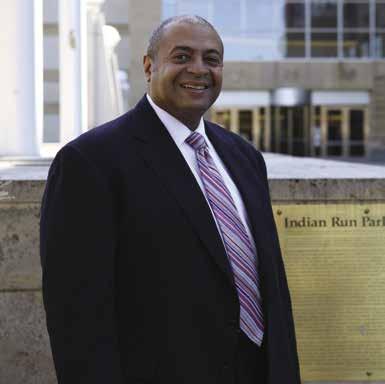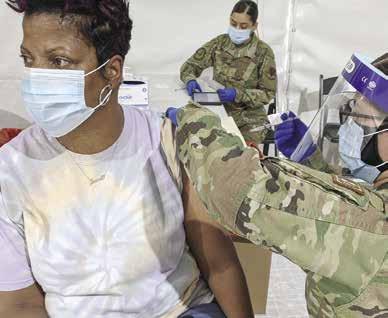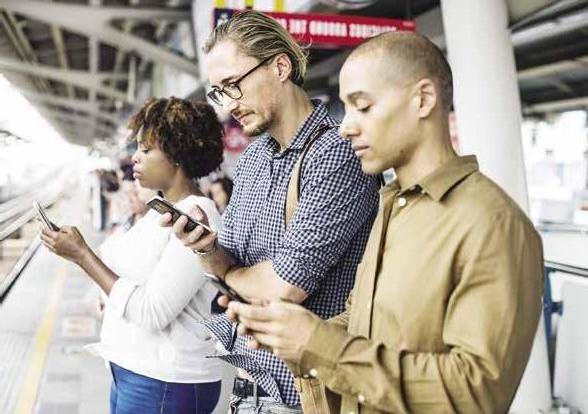HEALTH Fewer Johnson & Johnson Vaccines Coming to Maryland William J. Ford WI Staff Writer Marylanders will see a 250,000 decrease in doses of the Johnson & Johnson COVID-19 vaccine that could slow down vaccination efforts over the next two weeks. The decrease includes 78,000 fewer doses from what the state expects to receive this week from the federal government. In total, the state could receive a 33 percent reduction this week not only from Johnson & Johnson, which requires one dose but also from Pfizer and Moderna that requires two doses. “We’ve built this incredible infrastructure that can handle way more vaccines, but the last thing we wanted to hear about was we’re getting less vaccines,” Gov. Larry Hogan said during a news conference Friday, April 9 in Annapolis. “We were hoping they would continue to ramp up as they have been promising. It’s going to be a little slower in April. Hopefully we can catch up in May.” With limited information from federal officials, Hogan said the shortages may be linked to a disaster at Emergency BioSolutions manufacturing plant in Baltimore that produced vaccines for Johnson & Johnson, potentially ruining up to 15 million doses. The U.S. Food and Drug Administration hadn’t approved the plant to produce and distribute vaccines. Still, state officials anticipate possible approval to supply millions of other doses sitting in the plant.
20 APRIL 15 - 21, 2021
Hogan said “whatever the screwup was” appears to not involve those doses. “If the FDA issues an [emergency use authorization] for that facility, then they potentially have millions of doses to ship out immediately,” he said. A possible fourth vaccine could come from Novavax of Gaithersburg in Montgomery County, he said, and “is very close” to undergoing the third phase clinical trial as soon as next month. The limited numbers in vaccines are unfortunately happening with a more contagious variant circulating throughout Maryland and nationwide. According to the Mayo Clinic (www.mayoclinic.org/coronavirus-covid-19/map), the hot spots last week, based on confirmed cases per 100,000 people, are in Baltimore and Harford counties that border Pennsylvania. That state and most of the Northeast part of the country are designated hot spots. After Maryland reached a milestone in administering 82,000 shots Thursday, April 8, the state Health Department reported a new daily record of 94,773 on Friday. The goal for state officials is to deliver 100,000 shots per day. About 3.5 million Marylanders have received the vaccine, which equates to about 21 percent of the population. According to an automated message last week, Prince George’s County Health Officer Ernest Carter said 217,000 residents have been vaccinated.
Prince George’s continues to lead the state’s counties with over 80,000 confirmed coronavirus cases and over 1.400 deaths. “We can’t let our guard down yet,” he said. “COVID-19 is still spreading in Prince George’s County and is making a lot of people sick.” Residents who still haven’t pre-registered can do so at https://covid19vaccination. princegeorgescountymd.gov, or call the county’s 311 hotline. To register at one of the mass vaccination sites that include Six Flags America in Upper Marlboro and Greenbelt Metro station, go to https://coronavirus.maryland. gov/pages/vaccine, or call 1-855634-6892. WI @jabariwill
5 A woman receives a COVID-19 vaccine on April 7 at a vaccination clinic at the Greenbelt Metro station operated by the Federal Emergency Management Agency. (Photo courtesy of FEMA)
500,000 Enroll in Health Insurance During Special Period
Gains Registered Among African American, Traditionally Unsigned Groups Sarafina Wright WI Contributing Writer The U.S. Department of Health and Human Services says more than 500,000 Americans have enrolled in health insurance through HealthCare.gov as a result of the Biden Administration’s Special Enrollment Period [SEP] for the COVID-19 public health emergency. The department added that this has been the largest increase in enrollment among Black consumers and among Americans near the poverty level in two years. “Access to quality, affordable health care is essential – especially as we tackle the COVID-19 pandemic and its aftermath,” said
(Photo courtesy of Pexels.)
HHS Secretary Xavier Becerra. “Since the beginning of this Special Enrollment Period’s availability on HealthCare.gov, more than 500,000 Americans have already signed up for coverage on HealthCare.gov. Now, thanks to the American Rescue Plan, health care coverage is more affordable and millions of Americans are seeing their premiums reduced.” “At HHS, we are going to build on the Affordable Care Act [ACA] and work tirelessly to ensure Americans have the chance to sign up for quality, affordable health care coverage that meets their needs.” A report issued on Wednesday, April 7 from the Centers for Medicare & Medicaid Services [CMS], which covers plan selections from Feb. 15 to March 31, shows gains in enrollment among historically uninsured communities.
Of applicants who identified a race, 17 percent identified as Black – compared to about 11 percent in both 2020 and 2019 during the same period. Among consumers requesting financial assistance, 41 percent report being at or slightly above the federal poverty level, compared to 38 percent in 2020 and 33 percent in 2019. The HHS says nearly 15 million Americans who currently lack health insurance, and many current enrollees, are eligible to receive additional financial support in obtaining Marketplace coverage as part of the American Rescue Plan [ARP]. As of April, premiums are expected to decrease by an average of $50-per-person, per month – and $85-per-policy, per month due to the financial assistance available under the ARP. An average of four out of five consumers currently enrolled in Marketplace coverage can now find a plan for $10 or less per month after financial assistance says the HHS. The 2021 SEP is available to consumers in the 36 states with Marketplaces that use the HealthCare.gov platform through Aug. 15, 2021. WI
THE WASHINGTON INFORMER / WWW.WASHINGTONINFORMER.COM





